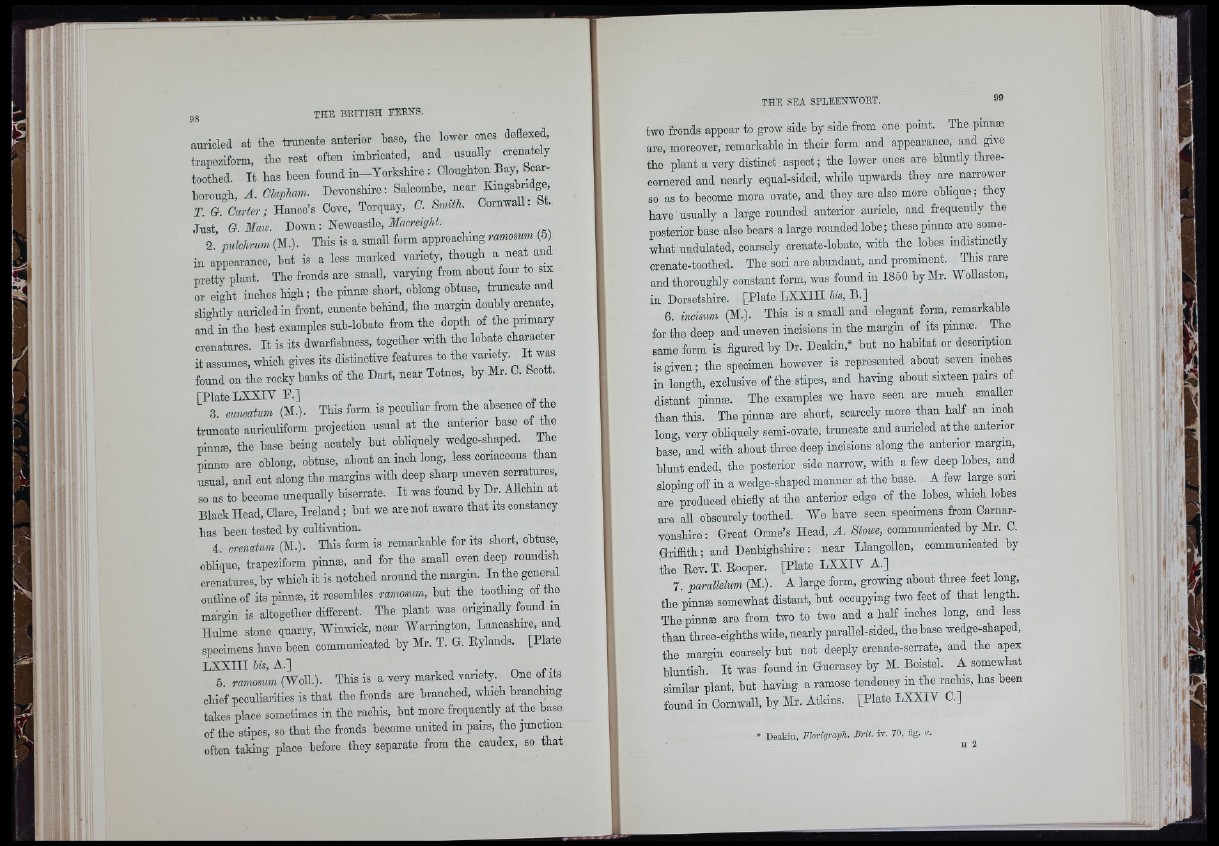
am-ioled at the truncate anterior hase, the lower ones deflexed,
trapeziform, the rest often imbricated, and usually crenately
J h e d . It has been found in-Yorkshire : Cloughton Bay Scar
borough, A. Clapham. Devonshire: Salcombe, near Kmgsbnd e
T. Q. Carter; Hanoe’s Cove, Torquay, C. Smith. CornwaU. •
Just, O. Maw. Down : Newcastle, Macreight.
2 pnlchrum (M.). This is a smaU form approaching ramomm (5)
in appearance, hut is a less marked variety though
nrottv plant. The fronds are small, varying from about four to six
or eight inches high ; the pinnæ short, ohlong obtuse trimcate an
sliriitly auricled in front, cuneate behind, tho margm donhly crenate,
and in the best examples sub-lobate from the depth of the primary
crenatures. It is its dwarfishness, together with the lobate character
it assumes. wHeh gives its distinctive features to the varmty. It was
found on the rocky banks of the Dart, near Totnes, by Mr. 0. Scott.
[Plate LXXIY F .] ,i u f+p
3. cuneatum (M.). Tbis form is pecuhar from the absence of the
truncate auriouUform projection usual at the anterior base of the
pinnæ, the base being acutely but obliquely wedge-shaped. The
pinnæ are oblong, obtuse, about an inch long, less coriaceous tban
usual, and out along the margins Yvith deep sharp uneven serratures
so as to become unequally biserrate. It was found by Dr Allchm at
Black Head, Clare, Ireland ; but we are not aware that its constancy
has been tested by cultivation. , ^ ,
4 crenatum (M.). This form is remarkable for its short, obtuse,
oblique, trapeziform pinnæ, and for the small even deep roundish
crenatures, by wHoh it is notched around the margin. In the general
outHne of its pinnæ, it resembles ramosum, but the toothing o± the
marrin is altogether different. The plant was originally found in
H u iL stone quarry, Winwick, near Warrington, Lancashire and
specimens have been communioated by Mr. T. G.. Hylands. [Plate
LXXIII bis. A.] , , • . o f u
5 ramosum (Woll.). T h i s i s a very marked variety. One of its
chief pecnHarities is that the fronds are branched, which branching
takes place sometimes in the raohis, but more frequently at tee base
of tee stipes, so teat the fronds become united in pairs, tee junction
often taHng place before they separate from tee caudex, so that
two fronds appear to grow side by side from one point. The pinnæ
are, moreover, remarkable in their form and appearance, and give
the plant a very distinct aspect; the lower ones are bluntly three-
cornered and nearly equal-sided, whüe upwards they are narrower
so as to become more ovate, and they are also more oblique; they
have usuaUy a large rounded anterior auricle, and frequently the
posterior base also bears a large rounded lobe; these pinnæ are somewhat
undulated, coarsely orenate-lobate, with the kbes indistinctly
crenate-toothed. The sori are abundant, and prominent. This rare
and thoroughly constant form, was fonnd in 1850 by Mr. WoUaston,
in Dorsetshire. [Plate LXXIII bis, B.]
6. inoisim (M.). This is a smaU and elegant form, remarkable
for the deep and uneven incisions in tee margin of its pinnæ. The
same form is figured by Dr. Dealdn,* but no habitat or desonption
is given ; tee specimen however is represented about seven inches
in length, exclusive of tee stipes, and having about sixteen pairs of
distant pinnæ. The examples we have seen are much smaUer
than this. The pinnæ are short, scarcely more than half an inch
long, very obliquely semi-ovate, truncate and auricled at tee anterior
base’, and with about three deep incisions along tee anterior margin,
blunt ended, the posterior side narrow, with a few deep lobes, and
sloping off in a wedge-shaped manner at the base. A few large son
are produced chiefly at the anterior edge of tee lohes, which lohes
are aU obscurely toothed. We have seen specimens from Carnarvonshire
: Great Orme’s Head, A. Stowe, communicated by Mr. 0.
Griffith; and DenbighsHre: near Llangollen, communicated by
tee Rev. T. Eooper. [Plate LXXIY A.] , n , ,
7. parallelum (M.). A large form, growmg about three feet long,
the pinnæ somewhat distant, but occupying two feet of that length.
The pinnæ are from two to two and a half inches long, and less
than three-eighths wide, nearly paraUel-sided, the base wedge-shaped,
tee margin coarsely but not deeply crenate-serrate, and the apex
bluntish It was found in Guernsey by M. Boistel. A somewhat
similar plant, but having a ramose tendency in the raohis, has been
found in Cornwall, by Mr. Atkins. [Plate LXXIV C.]
DeaMn, Florigraph. Br it iv. 70, fig. «.
s 2
:
f'-